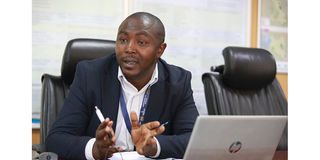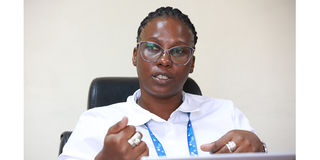What sector stakeholders are doing to reduce water losses, increase access
Sponsored by Water Sector Trust Fund

Eng Peter Koech, Manager of Water and Sanitation Services, Water Sector Trust Fund.
By Evans Ongwae
Kenya’s water and sanitation stakeholders are championing various measures to help reduce the Ksh10 billion annual non-revenue water losses. Taming these losses will see many more underserved Kenyans enjoy access to water and sanitation services, and boost sustainability in the sector.
Eng Peter Koech, the Manager of Water and Sanitation Services at the Water Sector Trust Fund (WaterFund), points out further that these losses have for many years remained stubborn, and are currently at 45 percent. This figure is nearly double the globally acceptable level of 25 percent or less.
Eng Koech notes that whereas several projects are ongoing with more in the pipeline, significantly cutting down water losses is paramount.
WaterFund’s Principal Programme Officer for Sanitation, Ms Violet Mucheni, asserts that this is critical, in view of the funding gap the water sector is grappling with amid growing demand for services.
WaterFund, through the Water and Sanitation Division, finances water and sanitation in low-income areas in both urban and rural Kenya. The programmes under the division include water, sanitation, emergency, special programmes, and research. The target beneficiaries include rural areas that are not commercially viable and underserved poor urban areas.

Ms Violet Mucheni, Principal Programme Officer for Sanitation, Water Sector Trust Fund.
Ms Mucheni says much more needs to be done to improve access to sanitation, which lags behind water provision. “Few counties have sewer connections,” she says. WASREB Impact 15 states that the national sewerage access stands at 16 percent.
Ms Mucheni adds that to reduce wastage, water firms should install smart metres so that consumers pay for only the amounts they have consumed. Installing leak detectors and fixing leakages in pipelines as soon as they are detected, are the other necessary intervention areas.
Water companies can also reduce the cost of pumping by going green and using solar or wind, instead of relying on national grid power. This is cascaded to implementing partners through WaterFund Green Growth Strategy.
Water policing units have also been introduced to fight cartels that may be contributing to the Non-Revenue Water problem. Additionally, the Kenya Water Institute (KEWI) is training plumbers to reduce commercial water losses.
The Water Services Regulatory Board (WASREB) collaborated with WaterFund, Gatsby Africa, and Caritas Switzerland to develop “Guidelines for Provision of Water and Sanitation Services in Rural and Underserved Areas in Kenya”. Published in 2019, it provides a legal framework for management of water in the rural space, which lags behind compared to urban areas.
WaterFund funded programmes seek to enhance water resources management, and increase access to water and sanitation services. The Fund is currently implementing Ending Drought Emergencies: Climate Proofed Infrastructure Programme (EDE-CPIRA), for improved water supply and sanitation in arid and semi-arid lands (ASALs) in eight counties, with financial support from the European Union. These counties are Baringo, Kajiado, Kilifi, Kitui, Mandera, Samburu, Taita Taveta, and West Pokot.
The programme started in 2017 and will end in August 2024. The overall budget is Ksh3 billion, and the implementing partners are Water Service Providers (WSPs) and Water Resources Users Associations (WRUAs).
EDE CPIRA comprises 24 projects. Ten (10) of them have been completed and are providing water to 150,000 people. Eight (8) projects are ongoing, and six (6) are just starting. Overall, the programme targets 360,000 beneficiaries. It further targets to build 36 public sanitation facilities. Twenty-eight (28) ablution blocks have already been completed. The programme’s other component is 20 water resource management projects, of which five (5) have been completed.
EDE CPIRA projects cover the water value chain, right from the source, to distribution and storage, and finally to the tap. This involves the uptake of water from a river, the drilling of boreholes, establishment of rising mains/distribution lines, water treatment works, and storage facilities.
With funding from the Government of Kenya and the Royal Danish Embassy, WaterFund is implementing a five-year Programme (July 2021-June 2026) with a budget of DKK 70 million (equivalent of Ksh1.2 billion then) titled, Sustainable Management and Access to Water and Sanitation in the ASALs (SWASAP).
The programme targets six (6) ASAL counties, namely Garissa, Isiolo, Lamu, Marsabit, Tana River, and Turkana. A total of 40,000 households will be reached within the rural areas of these six (6) counties through several integrated projects. The projects comprise integrated water resource management, and water and sanitation services.
The goal is to increase community resilience and adaptation to climate change through sustainable, peaceful use of natural resources, including improved access to water and sanitation services in the target ASALs counties.
SWASAP has diverse implementing partners from local and international non-governmental organisations (NGO), conservancies and consortiums that include Water Services Providers (WSP).
Seventeen (17) projects have been financed to a tune of Ksh778.9 million. This programme has a co-financing aspect where the six (6) counties will contribute Ksh123.6 million as part of the cash and in-kind support.
Implementation of the programme is on-going, and its envisaged beneficiaries should have increased water and sanitation access in 2025. It also addresses the refugee/host community nexus by targeting the refugees in Dadaab and Kakuma in Garissa and Turkana counties respectively.


